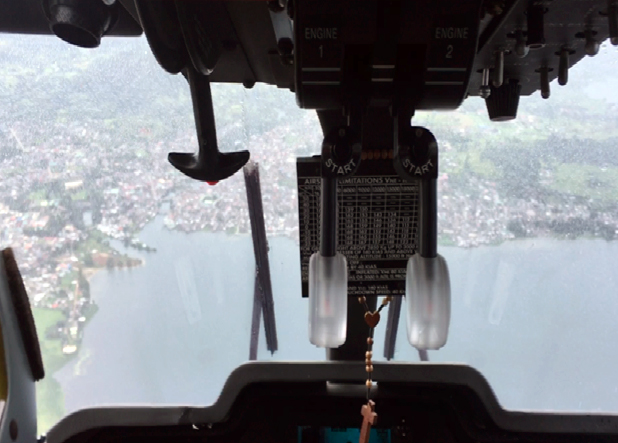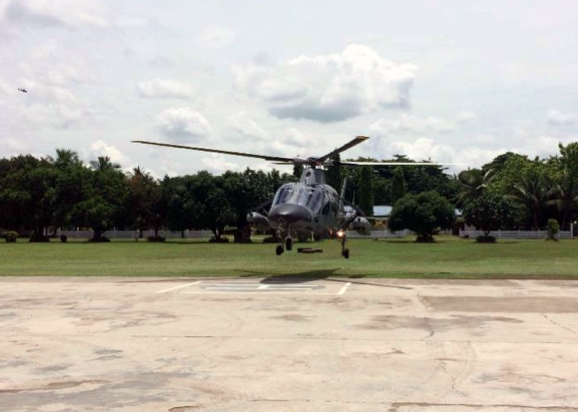As part of modernization, the Philippine Navy procured five new helicopters manufactured by Italy’s Agusta Westland to replace the ageing helicopters in its inventory. Three of these aircrafts that are in multi-role configuration were delivered in 2013 while the other two in armed-configuration came in 2015. These helicopters gave the Philippine Navy a great leap in terms of capabilities and are considered a progressive upgrade for modernization.

The Background. On 23-May-2017, Abu Sayyaf terrorists, led by Isnilon Hapilon and the Maute Group, under the leadership of the brothers Abdullah Maute and Omar Maute, seized and inflicted damage to some of the vital infrastructure of Marawi City. The combined forces of these terrorist groups that declared their affiliation with the Islamic State of Iraq and Levant (ISIL) intended to establish an independent ISIL state in Mindanao by means of jihad. With this primary objective, they captured government facilities such as the Marawi City Jail and Police stations, hospitals, schools, and desecrated and burned churches and other vital infrastructures to make their presence known and to show the world that they mean business. Along the way, they held hostages and went on a killing spree on government forces and innocent civilians, and continued to strengthen their ranks by threatening people to join their group or be killed. Such acts of terrorism led the Commander-in-Chief, President Rodrigo Duterte to sign Proclamation Nr 216, declaring Martial Law in all of Mindanao and the suspension of the privilege of Writ of Habeas Corpus.
A week later, the Navy celebrated of its 119th founding anniversary in Davao City where 2 naval helicopters participated in capability demonstrations to highlight the capability of the Helicopters for Naval Operations, particularly hostage rescue mission with no other than the President witnessing the same aboard ship.
The Call. Except for training flights and ground troop transport sorties in Jolo and Basilan, Naval helicopters had not been utilized at the forefront of any battle. Hence, the Navy pilots and crew had very limited experience in close air support. When the news broke out that Marawi was under siege, the pilots who were deployed for the Navy Anniversary air demo thought that the crisis would be quelled immediately and that government troops would easily overcome the terrorist group conducting “petty skirmishes” to disrupt the peace and order in that city.
But then, they were wrong. Soon thereafter, on 03-June-2017, the pilots were alerted to swing to actual combat operations when the Philippine Navy leadership decided that Naval Helos would be needed to augment the government troops in the frontline. With a high sense of morale and pride, the Naval pilots immediately responded to the call of duty and upon the issuance of formal directive, flew their aircraft on 06 June initially to Zamboanga City to get instructions from Commander, Naval Forces Western Mindanao Radm Rene V Medina AFP, then to Lumbia airport, Cagayan de Oro City where other aircraft of the AFP supporting front line troops are stationed.
This deployment was quite a challenge for the Naval Pilots considering that Naval Helos are supposed to be an extension of the capability of her mother ship. In the absence of a mothership, the Naval Helos are then isolated of their support facilities (i.e., billeting and messing of the pilots, refueling and maintenance of the aircraft, etc.). In short, the pilots were tasked to operate in an environment totally different from where they were doctrinally taught. With the great number of Air Force pilots and crew, along with their respective aircraft stationed in Cagayan de Oro, the Navy pilots had to look for their support requirements elsewhere. Fortunately, the Philippine Army’s 4th Infantry Division at Patag, Cagayan de Oro City warmly hosted them. Upon settling down and orienting themselves with the new environment, they immediately planned to proceed to where the action is: Marawi City.

One Naval Helo was under direct control of Naval Task Group (NTG) “Tiger” under Marine BGen Custodio Parcon AFP Commander (later transferred to Marine BGen Melquiades Ordiales) whose Tactical Command Post was located at the Mindanao State University (MSU) in Marawi. In order for the pilots to be oriented with the battle space, they had to fly and land at MSU to get the much needed reports and briefing prior to the conduct of combat sorties, and to setup necessary equipment that would allow the ground commander to see in real time a view of the battlefield. Later, reports indicated that the Navy pilots were considered brave enough to land at MSU since ISIL sympathizers reported the Naval helo’s frequent landings as a valuable target.
The Baptism. After orienting themselves on the campaign situation, the pilots geared for action to conduct their very first potential combat mission. Their initial sorties were more of a surveillance to search, locate and monitor enemy movements from the sky. But On 09 June, the first target given was Padian Wharf in Lanao Lake where enemy snipers targeted military personnel from the other side of the lake. After refueling and loading ammunitions at Lumbia, the Naval Helo took off and proceeded to its first combat mission (daytime). Unlike the Air Force, a single Naval helo can conduct an assault on its own. As a famous air strategist said:
“Would not the sight of a single enemy airplane be enough to induce a formidable panic? Normal life would be unable to continue under the constant threat of death and imminent destruction.”
– General Giulio Douhet, The Command of the Air, 1921
That single Naval Helo made attack dive passes until all her 500 rounds of munitions were depleted. Later that day, it was learned that Abdullah Maute was wounded in the attack at Padian Wharf. It then returned to Lumbia Airport to refuel and rearm, and immediately took off for another sortie. This time the target was a pick-up truck with mounted 50 cal guns that was spotted retaliating fire during the first sortie of the chopper. Exercising caution but still full of courage, the Naval Helo engaged another target where the terrorist group was reportedly situated.
The Glory. With 2 combat sorties in a row and a reconnaissance mission the night before, it was indeed a tiresome day for the pilots. By around 4 o’clock in the afternoon while elements of Marine Battalion Landing Team 10 (MBLT 10) were engaged in a firefight against members of the Maute Group at the vicinity of Rakila Compound, Makalilay Street, Marawi City, Joint Task Force Marawi requested the Philippine Air Force to conduct another sortie of Close Air Support (CAS) to ease enemy pressure on government troops that were surrounded and pinned down by heavy enemy gun fire, including Rocket Propelled Grenades (RPG), thereby leaving no maneuvering space to counter the enemy. The Air Force could provide only 1 helo. And, due to the numerous missions earlier that day, 1 Air Force helo had already exceeded its flying hours thus leaving its buddy alone and would therefore not be allowed to fly for close air support sortie as it would be a violation of Air Force doctrines.
Although highly exhausted from delivering 2 strike missions earlier, upon learning of the urgency of the CAS mission, the Naval Helo Pilot in Command (PIC) together with his co-pilot volunteered to undertake said mission to be in tandem with the PAF helo.
Immediately, the 2 PICs with their respective crew planned and sought clearance to fly in tandem despite differences in established doctrines. Upon receipt of clearance to proceed, the pilots and crew of both aircrafts rushed to respond to the desperate call for help from the Marines engaged in a firefight with the enemy. Shortly upon take-off however, the situation of the responding pilots became more difficult with the rapidly deteriorating weather, and evening twilight was setting in. Despite these challenges, the pilots skillfully flew their aircraft towards the combat zone with the objective of relieving enemy pressure on the pinned down troops, to enable them to safely maneuver and gain advantage in the ensuing battle.

Once the location of the enemy and government troops were pinpointed, the helos maneuvered and conducted air assault to suppress the enemy’s attack on government troops. To the government troops, the sight of the helos providing air support was a morale booster but to the enemy it was a nuisance, hence they directed retaliatory fire to the helos. In spite of this, the pilots of the 2 aircrafts pressed on. They boldly flew, an added risk on their lives, lower than usual to avoid dark clouds while evading enemy fire. After accurately expending all their cal 50 ammunition, the helos inflicted heavy casualty on the enemy, including the withdrawal of their snipers situated on rooftops, enabling the government troops to tactically maneuver to a vantage position. Aware that their aircraft was running low on fuel, and would be met by heavy rains in zero visibility and total darkness on their return to base, the pilots demonstrated exceptional courage and deep sense of duty.
This combat mission by an Air Force-Navy team hurriedly assembled, being the first of its kind, defined the essence of joint operations and demonstrated the synergy of the different armed services of the AFP.
The Lesson. Absent existing doctrine on counter-terrorism in an urban setting the Marawi incident provided considerable inputs in fighting terrorists. For one, technology significantly helps in locating, monitoring and suppressing the enemy. For another, morale and leadership boost the troop’s will to fight. Also, command and control system is vital in harnessing synergy of the various components of the armed forces.
About 2 weeks before the end of the battle however, the Naval Helos were pulled out from the scene to respond to other missions at Basilan, Jolo, and Tawi tawi. Given the concentration of AFP assets at Marawi, the other sectors of threat needed to be safeguarded as well. Despite the fact that we never saw the end of the battle in Marawi, we could certainly say, “We were there too!” We were there for love of country and the Filipino people.
